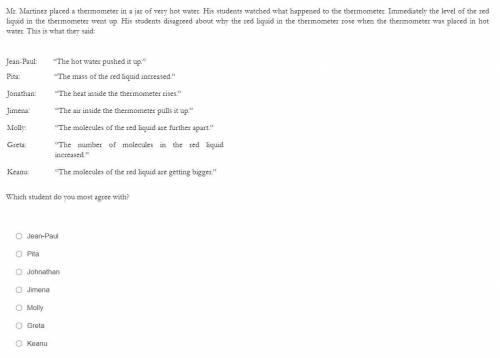
Chemistry, 03.12.2020 20:10 thomisonariel9800
Mr. Martinez placed a thermometer in a jar of very hot water. His students watched what happened to the thermometer. Immediately the level of the red liquid in the thermometer went up. His students disagreed about why the red liquid in the thermometer rose when the thermometer was placed in hot water. This is what they said: Jean-Paul: “The hot water pushed it up.” Pita: “The mass of the red liquid increased.” Jonathan: “The heat inside the thermometer rises.” Jimena: “The air inside the thermometer pulls it up.” Molly: “The molecules of the red liquid are further apart.” Greta: “The number of molecules in the red liquid increased.” Keanu: “The molecules of the red liquid are getting bigger.” Which student do you most agree with?


Answers: 1


Another question on Chemistry

Chemistry, 22.06.2019 07:30
All cells are made of four types of acids, lipids, proteins, and carbohydrates.
Answers: 1

Chemistry, 22.06.2019 18:30
The famous scientist galileo galilei did several experiments with sloping planes, which he rolled metal balls down so that he could study motion. by changing the slope, he could study how the speed at which the ball rolled was affected. what was the independent variable in galileo's experiment? a. the speed of the ball b. the slope of the plane c. whether the ball moved d. what the ball was made of
Answers: 2

Chemistry, 22.06.2019 19:30
Awoman's basketball has a circumference between 28.5 and 29.0 inches and a maximum weight of 20 ounces (two significant figures). what are these specifications in units of centimeters and grams?
Answers: 2

Chemistry, 23.06.2019 05:00
How is electrolysis most commonly used to produce an energy source? a - splitting water molecules produces oxygen, which organisms breathe to fuel their bodies. b - splitting water molecules produces hydrogen gas, which is used to power machines through hydrogen fuel cells. c - splitting carbon dioxide molecules produces coal, a form of carbon that can be burned to produce heat. d - splitting carbon dioxide molecules produces natural gas, which can be burned to generate electricity in power plants.
Answers: 1
You know the right answer?
Mr. Martinez placed a thermometer in a jar of very hot water. His students watched what happened to...
Questions

Biology, 26.01.2021 14:00

Engineering, 26.01.2021 14:00



Mathematics, 26.01.2021 14:00


Mathematics, 26.01.2021 14:00


Biology, 26.01.2021 14:00


Mathematics, 26.01.2021 14:00

Mathematics, 26.01.2021 14:00





Business, 26.01.2021 14:00

Chemistry, 26.01.2021 14:00




